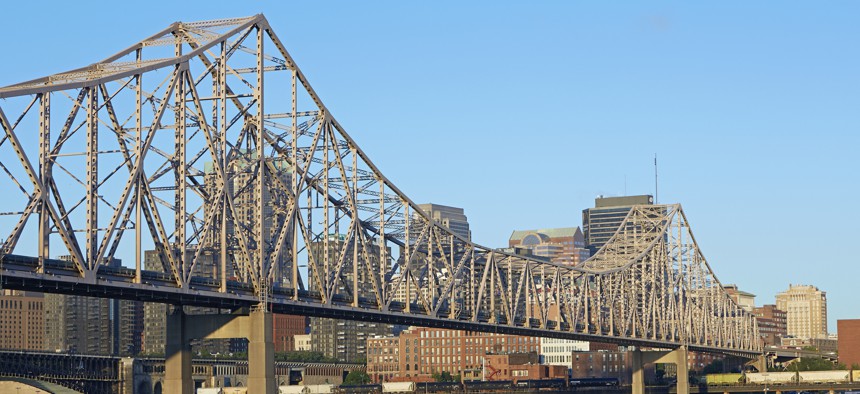Infrastructure Update: $6B Federal Bridge Funding Boost Arrives for Small Localities

Martin Luther King Bridge in St. Louis gettyImages/Allan Baxter
With thousands of city and county bridges in “poor condition,” local leaders say “It’s about time.”
This is an archived version of Route Fifty's weekly Infrastructure Update newsletter. Subscribe here to receive the newsletter by email.
****
The Biden administration has started doling out new money to repair bridges, and local government officials are ecstatic.
The $40 billion in bridge money included in the new federal infrastructure package is especially beneficial to smaller communities that found it hard to compete for dollars from Washington under previous highway funding laws.
Hello and welcome back to Route Fifty's Infrastructure Update, I’m Dan Vock. This week, we’ll explore why the bridge-repair money in the Infrastructure Investment and Jobs Act has county and city officials, in particular, so excited.
“Hallelujah, it’s about time,” said Clarence Anthony, the CEO and executive director of the National League of Cities, on a call with reporters Friday. “Oftentimes, when Americans think of bridges, they think of big bridges. [But the bridges] that are small, that connect rural communities and tribal communities, are important as well.”
The new infrastructure law’s bridge program is especially beneficial to local governments in several ways:
- It sets aside 15% of bridge funds given to states for “off system” bridges that are not part of the national highway system, effectively meaning that they are usually on roads in smaller communities. That translates to at least $6.75 million in every state. Off-system bridges make up two-thirds of the 45,000 bridges in the country that are rated as being in “poor condition,” according to the Biden administration.
- States will still decide which bridge projects get federal dollars. But the federal government will pick up 100% of the cost of projects for off-system bridges, if those bridges are owned by a local government.
- It allows local governments and metropolitan planning organizations—not just state transportation departments – to apply for competitive grants for large bridge projects.
In remarks Friday, President Biden highlighted the potential benefits of spending money on off-system bridges.
“These are the bridges that are often overlooked when decisions are being made. But they are essential for small towns, rural towns, farmers to get their products to market, small businesses to be able to serve customers,” Biden said.
“These are the bridges that, when they’re closed, shut off deliveries and routes to school, work, and home. They create longer delays for first responders when every second counts,” he added.
Kate Kruller, a member of the city council in Tukwila, Washington, told reporters Friday that the policy shift will let her hometown finally be able to win federal bridge money.
“We’ve never had the opportunity to get access to money for these off-system bridges without competing with much bigger cities,” Kruller said. “We never win a competition when Seattle needs some work done.”
But the city of 20,000 residents just south of Seattle still has crucial bridge repair needs, she said. One bridge in particular handles 3,000 trucks a day going in and out of an intermodal facility for the BNSF railroad, as well as 7,000 cars. But the 280-foot-long steel structure scored just 7.56 out of 100 on a federal bridge rating scale, and as a precaution local authorities only allowed one truck at a time to pass over it, Kruller said.
Then, in December, a semi-truck with a too-tall load hit the beams overhead, which caused critical damage to the whole bridge. The city has had to shut down the span while it is repaired, which is expected to take six weeks.
“All of these trucks are now wandering through neighborhoods and using alternative access points that are very, very steep in grade and difficult for them to maneuver. We are extremely concerned,” Kruller said.
The city has been able to find money to start designing a new bridge, but “we just simply have no money” to build the replacement, she said.
The set asides for off-network bridges could change that.
“This is mighty big medicine for small cities and medium cities, where there are zero resources to make repairs or replace these bridges,” she said. “This is what the people in America need from the U.S. Department of Transportation and we couldn’t be happier.”
New Money for Small and Large Projects
The Biden administration, meanwhile, touted the ways that the new money could help both large and small projects. Transportation Secretary Pete Buttigieg made an appearance at the Martin Luther King Drive Bridge that crosses the Schuylkill River in Philadelphia, which is closed to motor vehicle traffic for two years while it is being repaired.
The president highlighted many other marquee projects that could finally get off the ground: the Brent Spence Bridge between Cincinnati and northern Kentucky, the Interstate 5 crossing over the Columbia River between Oregon and Washington, and the Blatnik Bridge between Duluth, Minnesota and Superior, Wisconsin.
That’s it for this week’s edition. If you haven’t already, consider signing up here for Route Fifty Today, our daily newsletter, where you can stay up to date on the latest trends and best practices happening in state and local government nationwide. If you have news tips or feedback, if you want to share your community’s story, or if you just want to say hello, please email me at dvock@govexec.com and follow me on Twitter at @danvock. Thanks for reading!
NEXT STORY: Detroit tests cloud-enabled pavement monitoring






